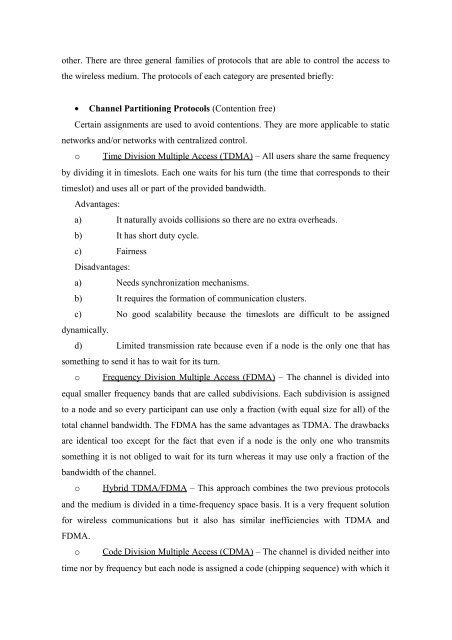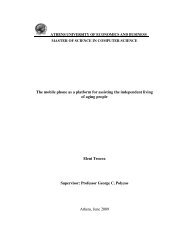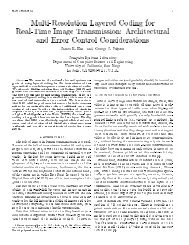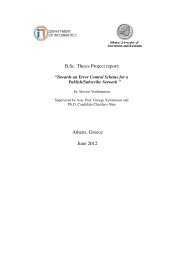In Network Processing and Data Aggregation in
In Network Processing and Data Aggregation in
In Network Processing and Data Aggregation in
Create successful ePaper yourself
Turn your PDF publications into a flip-book with our unique Google optimized e-Paper software.
other. There are three general families of protocols that are able to control the access tothe wireless medium. The protocols of each category are presented briefly:• Channel Partition<strong>in</strong>g Protocols (Contention free)Certa<strong>in</strong> assignments are used to avoid contentions. They are more applicable to staticnetworks <strong>and</strong>/or networks with centralized control.o Time Division Multiple Access (TDMA) – All users share the same frequencyby divid<strong>in</strong>g it <strong>in</strong> timeslots. Each one waits for his turn (the time that corresponds to theirtimeslot) <strong>and</strong> uses all or part of the provided b<strong>and</strong>width.Advantages:a) It naturally avoids collisions so there are no extra overheads.b) It has short duty cycle.c) FairnessDisadvantages:a) Needs synchronization mechanisms.b) It requires the formation of communication clusters.c) No good scalability because the timeslots are difficult to be assigneddynamically.d) Limited transmission rate because even if a node is the only one that hassometh<strong>in</strong>g to send it has to wait for its turn.o Frequency Division Multiple Access (FDMA) – The channel is divided <strong>in</strong>toequal smaller frequency b<strong>and</strong>s that are called subdivisions. Each subdivision is assignedto a node <strong>and</strong> so every participant can use only a fraction (with equal size for all) of thetotal channel b<strong>and</strong>width. The FDMA has the same advantages as TDMA. The drawbacksare identical too except for the fact that even if a node is the only one who transmitssometh<strong>in</strong>g it is not obliged to wait for its turn whereas it may use only a fraction of theb<strong>and</strong>width of the channel.o Hybrid TDMA/FDMA – This approach comb<strong>in</strong>es the two previous protocols<strong>and</strong> the medium is divided <strong>in</strong> a time-frequency space basis. It is a very frequent solutionfor wireless communications but it also has similar <strong>in</strong>efficiencies with TDMA <strong>and</strong>FDMA.o Code Division Multiple Access (CDMA) – The channel is divided neither <strong>in</strong>totime nor by frequency but each node is assigned a code (chipp<strong>in</strong>g sequence) with which it








